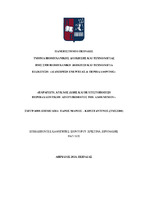Παραγωγή, κύκλος ζωής και βελτιστοποίηση περιβαλλοντικού αποτυπώματος αλουμινίου
Production, life cycle and optimization of aluminum environmental footprint

Master Thesis
Συγγραφέας
Τάρος, Μάριος Κωνσταντίνος
Ημερομηνία
2024-04Επιβλέπων
Ειρηνάκης, ΠαύλοςΣιοντόρου, Χριστίνα
Προβολή/
Λέξεις κλειδιά
Αλουμίνιο ; Αλουμίνα ; Βωξίτης ; Παραγωγή ; ΚαθετοποίησηΠερίληψη
Η παρούσα διπλωματική εργασία εκπονήθηκε με σκοπό την ανάλυση του κύκλου ζωής
και της γραμμής παραγωγής του αλουμινίου, με παράλληλη έμφαση στις παραγωγικές
και εξαγωγικές ικανότητες της Ελλάδας, και τις δυνατότητες που παρέχουν νέες
τεχνολογίες και ερευνητικά έργα όσον αφορά τον αυτοματισμό της παραγωγής και την
βελτίωση του περιβαλλοντικού αποτυπώματος του συγκεκριμένου υλικού. Οι στόχοι της
εργασίας περιλαμβάνουν τη σύνθεση μίας ολοκληρωμένης εικόνας της γραμμής
παραγωγής του αλουμινίου στην Ελλάδα, την παρουσίαση δεδομένων σχετικά με τις
εξαγωγικές δυνατότητες της, και την αναφορά των νέων τεχνολογιών οι οποίες μπορούν
να χρησιμοποιηθούν ώστε να βελτιστοποιηθεί ο κύκλος ζωής του αλουμινίου ως προς
τον περιβαλλοντικό αντίκτυπό της.
Στο πρώτο κεφάλαιο παρουσιάζεται αναλυτικά η γραμμή παραγωγής του
αλουμινίου, από την εξόρυξη της πρώτης ύλης ως και τις μεθόδους διάθεσης των
προϊόντων στο τέλος του κύκλου ζωής τους, με έμφαση στις παραγωγικές εγκαταστάσεις
στην Ελλάδα και την εξαγωγική δραστηριότητά τους, με μία παράλληλη αναφορά
σχετικά με τις διεθνείς τάσεις στον τομέα της έρευνας.
Εν συνεχεία, παρατίθενται στοιχεία σχετικά με νέες τεχνολογίες και μεθόδους
που χρησιμοποιούν οι προαναφερθείσες εγκαταστάσεις οι οποίες λειτουργούν στην
Ελλάδα, με στόχο τόσο την αποδέσμευση του ενεργειακού τους μείγματος από τα ορυκτά
καύσιμα, όσο και τη βελτιστοποίηση των διεργασιών που εκτελούνται στη γραμμή
παραγωγής του αλουμινίου για την αύξηση της απόδοσης και την παράλληλη μείωση
των ρύπων.
Στο 3ο
κεφάλαιο γίνεται αναφορά σε καινοτομίες στον τομέα της παραγωγής
αλουμινίου σε παγκόσμιο ερευνητικό επίπεδο οι οποίες παρουσιάζουν ενδιαφέρον
σχετικά με την ανάκτηση πρώτων υλών, τη μείωση της περιβαλλοντικής ρύπανσης από
τα λύματα και τα παραπροϊόντα του αλουμινίου, και οι οποίες προσφέρουν τη
δυνατότητα ένταξής τους στον κύκλο διεργασιών της γραμμής παραγωγής για την
επίτευξη των στόχων βιώσιμης ανάπτυξης των εταιριών παραγωγής αλουμίνας και
αλουμινίου.
Τέλος, παρατίθενται συνοπτικά τα συμπεράσματα της εργασίας και η ανάλυση
της συμβατότητάς τους με την ελληνική καθετοποιημένη γραμμή παραγωγής.


